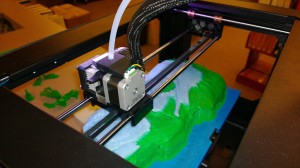On an infomercial, late at night, you might see a cheery personality telling you how you can preserve your bones with the help of 3D printing, tempting you to pick up that phone and dial now. Then, you might realize that the bones being made to last longer are that of Oncorhynchus rastrosus, a 5 million year old, saber-toothed salmon.

The seven-foot-long salmon ancestor is a rare specimen, the first of its kind ever discovered, making it both a subject worthy of study and preservation. That’s why science librarian Dean Walton at the University of Oregon (UO) used the library’s Replicator 2 to print out a copy of the creature’s skeletal remains. Using a CT scan already on file, Walton was able to reproduce parts of the fish, first starting with smaller pieces, to test the feasibility of the process, and moving onto the skull and jawbone, printing them in three pieces. Walton explained that, after printing, “[paleontologists] can take the model, make a cast, and have a legitimate, accurate copy without ever having touched the real fossil.”

By printing an accurate copy of the fossil, students and UO library visitors can handle the reproduction, while the original stays intact, stored away for safe keeping. Copies can also be sent to other institutions for the same purpose. Though the reproductions can provide enlightening information about the size and structure of the original saber-toothed salmon, they lack the radioactive isotopes found in the original. Such chemical analysis of the fossils elucidated to scientists that the fish were born in freshwater, but moved out to sea where they spent most of their lives, only returning to freshwater to spawn. As a dreamer, I hope that the medical scanners of the future can register the chemical data, too, which will be sent to an advanced molecular printer that creates an exact replica of a fossil, radiation and all.
In the meantime, the library will be printing models of fossilized hominid skulls to contribute to the work of anthropologist Stephen Frost. Because Frost cannot bring samples discovered in Africa back to the university, he’ll snap photos of the skulls on site, stitch the pics together in 3D modeling software, and print 3D copies at UO. The printer is currently free for use by faculty and staff, but students may use the Replicator for school projects, as well. One grad student was even able to reproduce a geological model for a presentation at the annual meeting of the American Geological Union.
Source: Library Journal


